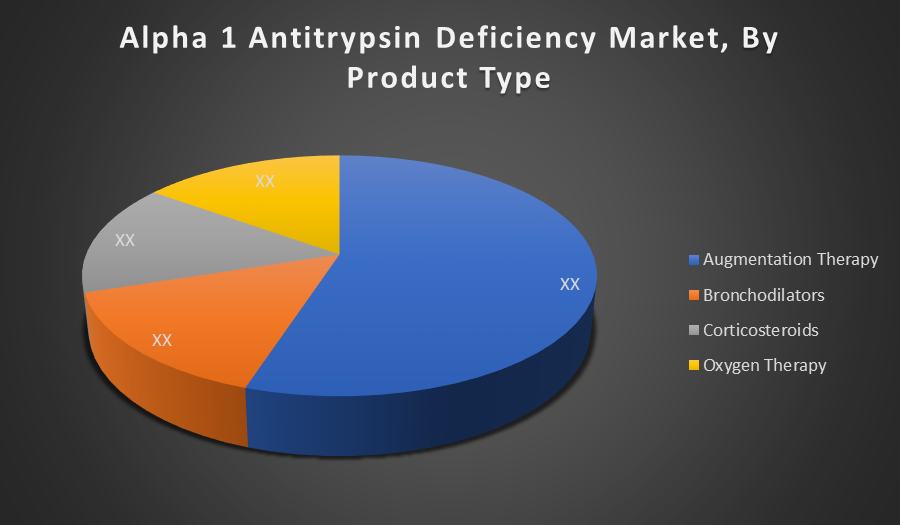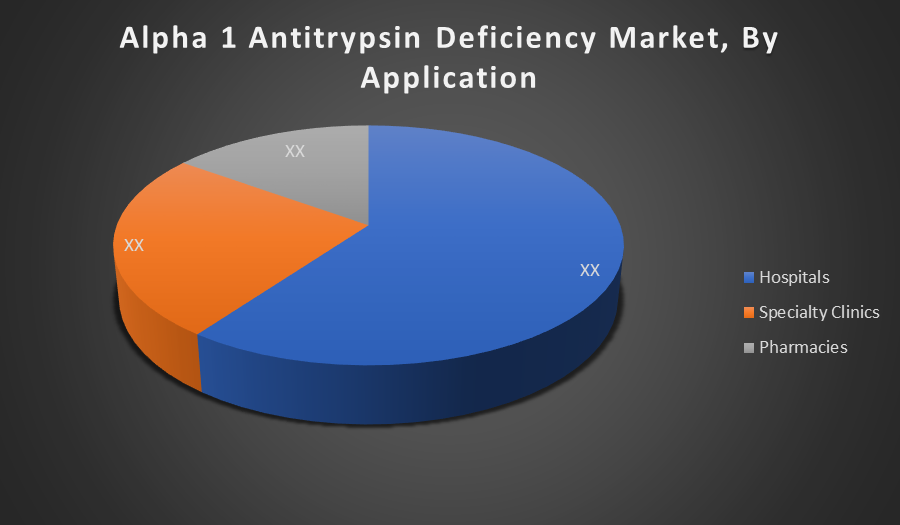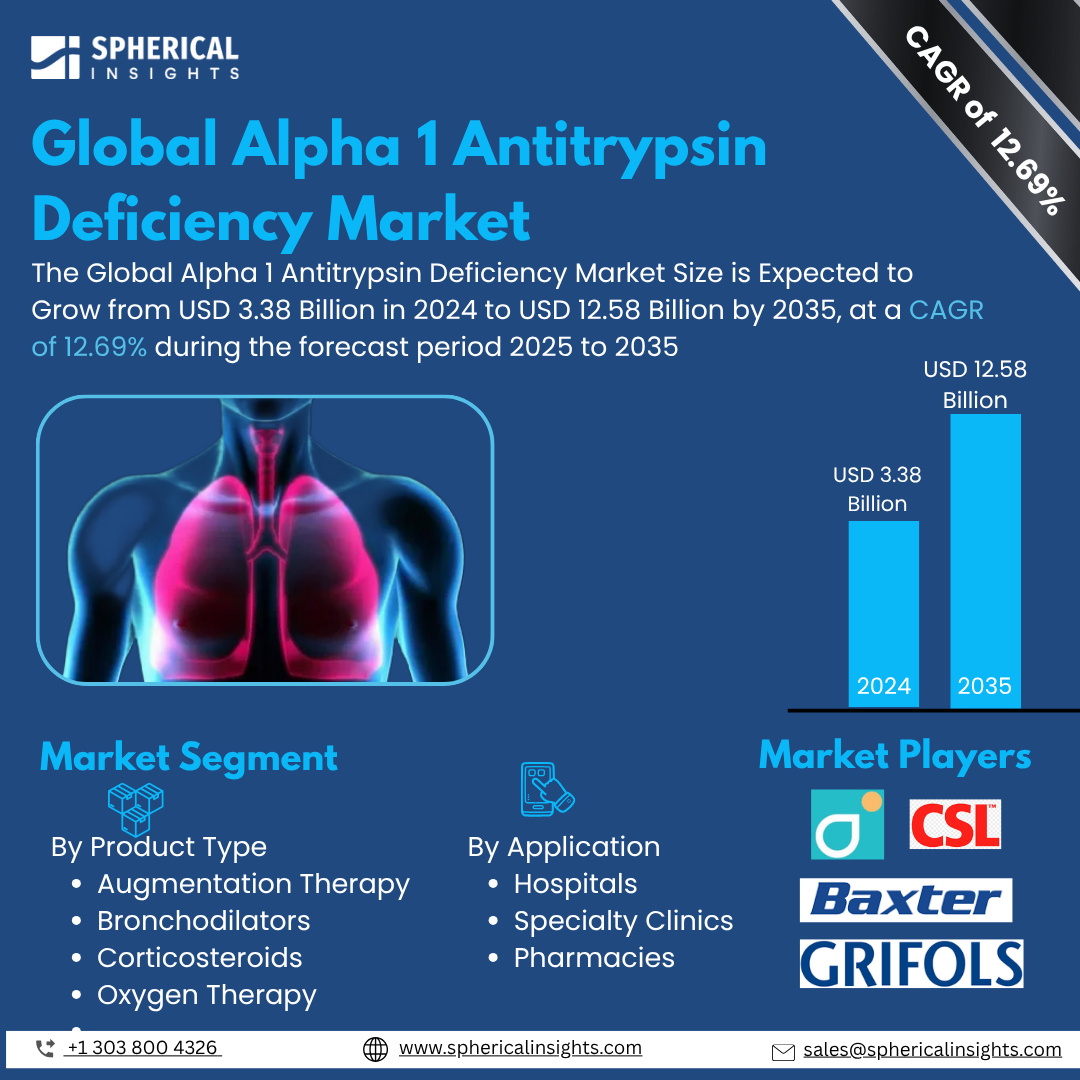- As per Spherical Insights & Consulting, The Global Alpha 1 Antitrypsin Deficiency Market Size is Expected to Grow from USD 3.38 Billion in 2024 to USD 12.58 Billion by 2035, at a CAGR of 12.69% during the forecast period 2025 to 2035, owing to the launch of new therapies in the market and the rise in the number of cases.
- The leading Alpha 1 Antitrypsin Deficiency Market Companies such as Kamada Ltd., CSL Behring, LFB Group, Baxter International, Takeda Pharmaceutical, Grifols, Bio Products Laboratory, Octapharma AG, Sanquin, Baxalta, Kedrion Biopharma, CSL Limited, Aralast, Baxter BioScience, ZLB Behring, and Others.
Alpha 1 Antitrypsin Deficiency Treatment Market: Understanding and Treatment Algorithm:
Alpha 1 Antitrypsin Deficiency (AATD) is a rare inherited disorder where the body produces insufficient or abnormal alpha 1 antitrypsin protein. This protein protects the lungs from inflammation caused by infections or irritants. Deficiency can lead to early-onset emphysema or liver disease, especially in adults and children.

Alpha 1 Antitrypsin Deficiency Diagnosis:
Diagnosis of AATD typically involves blood tests to measure alpha 1 antitrypsin levels, genetic testing to identify mutations, and lung function tests to assess respiratory impact. Newborn screening and family testing are also used. Early and accurate diagnosis is crucial for timely intervention and effective disease management.
Alpha 1 Antitrypsin Deficiency Treatment:
Treatment includes augmentation therapy to restore normal alpha 1 antitrypsin levels, and medications like bronchodilators or corticosteroids to manage symptoms. Oxygen therapy is used in advanced cases. Emerging treatments, including RNA based drugs and subcutaneous formulations, aim to provide more targeted and convenient management options for patients with AATD.
Alpha 1 Antitrypsin Deficiency Epidemiology:
The disease epidemiology covered in the report provides historical as well as forecasted epidemiology segmented by Total Diagnosed Incident Population of Alpha 1 Antitrypsin Deficiency, Gender specific Diagnosed Incidence of Alpha 1 Antitrypsin Deficiency, Type specific Diagnosed Incidence of Alpha 1 Antitrypsin Deficiency, Age specific Diagnosed Incidence of Alpha 1 Antitrypsin Deficiency, Diagnosed Incident Population based on Primary Site of Alpha 1 Antitrypsin Deficiency, and Diagnosed Incident Population based on Histologic Classification of Alpha 1 Antitrypsin Deficiency Tumour in the global market covering North America, Europe, Asia-Pacific, Latin America, the Middle East, and Africa from 2024 to 2035.
Principal Insights:
This section offers a global overview of Alpha 1 Antitrypsin Deficiency epidemiology in major markets worldwide.
Country Wise Alpha 1 Antitrypsin Deficiency Multiforme Epidemiology:
- The epidemiology segment provides Alpha 1 Antitrypsin Deficiency prevalence data and findings across key regions worldwide, including North America, Europe (Germany, France, Italy, Spain, and the United Kingdom), Asia-Pacific (including Japan), Latin America, the Middle East, and Africa.
Alpha 1 Antitrypsin Deficiency Recent Developments:
- In February 2024, Grifols announced that it had introduced new 4 gram and 5 gram vials of Prolastin, its alpha 1 antitrypsin augmentation therapy. This development aimed to simplify dosing, reduce packaging waste, and improve storage efficiency. The rollout began in Germany and Denmark, with plans to expand across Europe.
Alpha 1 Antitrypsin Deficiency Marketed Drugs:
• Prolastin C: Grifols
Prolastin C is an alpha 1 proteinase inhibitor used as augmentation therapy for patients with AATD. It helps raise the levels of alpha 1 antitrypsin in the blood, slowing the progression of emphysema caused by the deficiency. Administered intravenously, it is FDA approved and widely used in long term maintenance therapy.
• Glassia: Takeda Pharmaceutical
Glassia is a liquid, ready-to-use alpha 1 proteinase inhibitor used for chronic augmentation therapy in adults with AATD and emphysema. It is administered intravenously and provides a consistent dose to maintain protective AAT levels in the lungs.
Alpha 1 Antitrypsin Deficiency: Emerging Therapies:
- Fazirsiran: It is an RNA interference (RNAi) therapeutic targeting the mutant Z alpha 1 antitrypsin mRNA in the liver. It aims to reduce the accumulation of the toxic protein, thereby treating liver manifestations of Alpha 1 Antitrypsin Deficiency. Currently in Phase 3 trials, it offers a novel approach beyond traditional augmentation therapy.
- Alpha1 15%: Subcutaneous is a high concentration formulation of alpha 1 proteinase inhibitor developed for subcutaneous administration. Designed for at home self injection, it offers a more convenient alternative to intravenous therapy. In early clinical trials, it demonstrated favourable safety and pharmacokinetics, supporting its potential use in chronic AATD management.
Alpha 1 Antitrypsin Deficiency Market Outlook:
- The Alpha 1 Antitrypsin Deficiency market comprises diagnostics and therapeutic interventions aimed at managing the genetic disorder caused by deficient levels of alpha 1 antitrypsin protein. The market includes augmentation therapy, symptom management drugs, and evolving RNA based treatments to address lung and liver complications associated with AATD.
- Increasing prevalence of genetic respiratory disorders, rising awareness about AATD, and advancements in diagnostic tools are key drivers. Additionally, the availability of targeted augmentation therapies and growing investments by pharmaceutical companies are significantly propelling the global market for Alpha 1 Antitrypsin Deficiency treatment.
- The market presents strong growth opportunities through the development of subcutaneous formulations, RNA-targeted therapies, and personalized treatment approaches. Expansion in emerging markets and increased access to advanced healthcare solutions are further enhancing the growth potential, especially as diagnosis rates improve globally.
- Governments in North America and Europe have implemented newborn screening programs, rare disease registries, and funding for AATD research. These efforts aim to improve early diagnosis, promote patient education, and support the development of innovative therapies for Alpha 1 Antitrypsin Deficiency.
- Limited disease awareness and delayed diagnosis continue to hinder early treatment and management of AATD.
- Projected market growth is primarily driven by rising clinical trials, novel therapeutic developments, and increasing global access to specialized treatments.
Alpha 1 Antitrypsin Deficiency Market Segmentation:
By Product Type:
- Augmentation Therapy
- Bronchodilators
- Corticosteroids
- Oxygen Therapy

Augmentation Therapy holds the largest share because it directly addresses the root cause of AATD by supplementing the deficient alpha-1 antitrypsin protein. This targeted treatment slows disease progression, making it the preferred and most effective option over symptomatic treatments like bronchodilators, corticosteroids, and oxygen therapy, which primarily manage symptoms rather than the underlying deficiency.
By Application:
- Hospitals
- Specialty Clinics
- Pharmacies

Hospitals dominate the market share due to their comprehensive infrastructure for diagnosing and administering complex therapies like augmentation therapy. Hospitals offer multidisciplinary care, access to advanced diagnostic tools, and trained specialists, enabling effective management of AATD compared to specialty clinics and pharmacies, which have limited resources for such specialized treatment.
Regional Segment Analysis of the Alpha 1 Antitrypsin Deficiency Market:
North America holds the largest share in the Alpha 1 Antitrypsin Deficiency market due to advanced healthcare infrastructure, high awareness levels, and better diagnosis rates. Strong presence of key pharmaceutical companies, favourable reimbursement policies, and established distribution channels further boost market dominance. Additionally, extensive research and clinical trials focused on rare diseases drive the adoption of innovative therapies in this region.
The Asia Pacific region is the fastest-growing market for Alpha 1 Antitrypsin Deficiency, driven by rising healthcare expenditure, improving diagnostic capabilities, and increasing awareness of rare genetic disorders. Expanding healthcare infrastructure and growing access to advanced therapies in emerging economies like China and India contribute significantly. Moreover, government initiatives and rising patient population are fueling demand for effective treatment options in this region.
Alpha 1 Antitrypsin Deficiency Market Key Companies:
- Kamada Ltd.
- CSL Behring
- LFB Group
- Baxter International
- Takeda Pharmaceutical
- Grifols
- Bio Products Laboratory
- Octapharma AG
- Sanquin, Baxalta
- Kedrion Biopharma
- CSL Limited
- Aralast
- Baxter BioScience
- ZLB Behring
- Others
Market Segment:
This study forecasts revenue at the global, regional, and country levels from 2020 to 2035. Spherical Insights has segmented the Alpha 1 Antitrypsin Deficiency market based on the following segments:
Global Alpha 1 Antitrypsin Deficiency Market, By Product Type
- Augmentation Therapy
- Bronchodilators
- Corticosteroids
- Oxygen Therapy
Global Alpha 1 Antitrypsin Deficiency Market, By Application
- Hospitals
- Specialty Clinics
- Pharmacies
Global Alpha 1 Antitrypsin Deficiency Market, By Regional Analysis
- North America
- Europe
- Germany
- UK
- France
- Italy
- Spain
- Russia
- Rest of Europe
- Asia Pacific
- China
- Japan
- India
- South Korea
- Australia
- Rest of Asia Pacific
- South America
- Brazil
- Argentina
- Rest of South America
- Middle East & Africa
- UAE
- Saudi Arabia
- Qatar
- South Africa
- Rest of the Middle East & Africa






